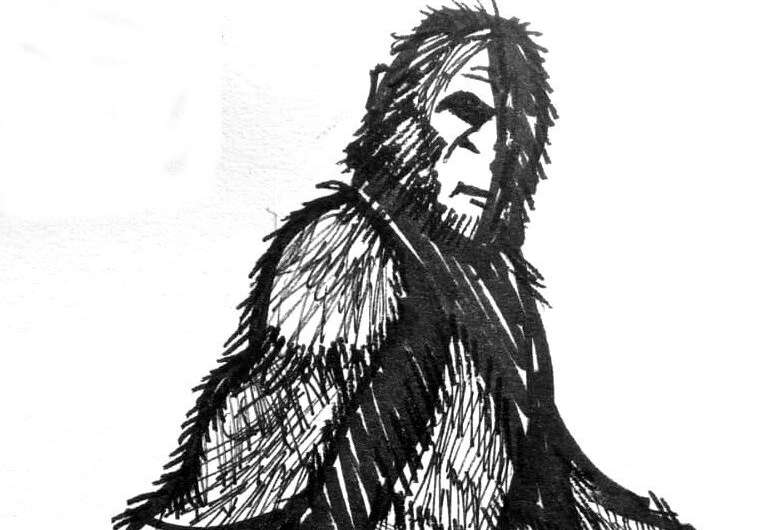
There are many stories of ape creatures found throughout the world in both mythology and modern day sightings. To date, a creature fitting the description has not been capture and studied, so researchers continue their quest for physical evidence.
Some reports have proven to be hoaxed while others, or misidentifications, especially those past down in the folklore of indigenous tribes, may hold truth about other beings that exist on planet Earth, and have always been part of its history. Based on reported behavior patterns, they do not wish to interact with humans - perhaps out of fear or for other reasons. We are after all - not the friendly species.
In pursuit of Bigfoot: The people searching for the truth behind the mystery PhysOrg - November 20, 2025

People hunting for Bigfoot use sophisticated techniques for collecting and validating evidence, drawing on scientific methods to try and prove its existence, research shows. Bigfooters are members of a passionate community of cryptozoologists, with many going to great lengths searching for evidence of a creature which has never been confirmed by conventional science.
C2C's Best Bigfoot Stories of 2020 Coast 2 Coast - December 30, 2020
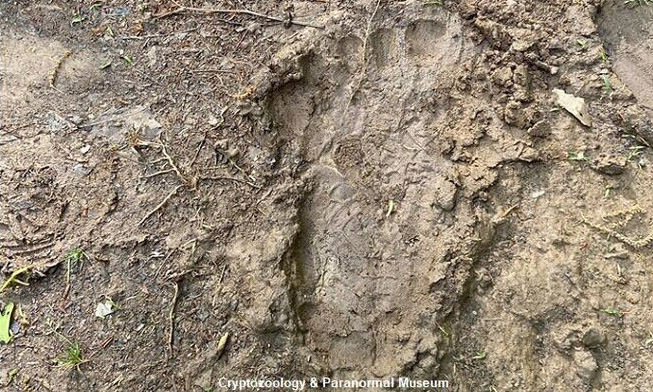
In keeping with the strangeness that was 2020, as people around the world familiarized themselves with the concept of 'social distancing,' Bigfoot was jokingly cast by many as a veritable mascot for the practice. Despite unexpectedly being celebrated as the ultimate example of extreme isolation, Sasquatch was actually not all that hard to find in the headlines this year. There were a handful of instances wherein the legendary cryptid may have been caught on film, incidents in which evidence of its existence might have been found, and moments where it was once again apparent that the 'beast' has become something of a pop culture icon.
Local woman collects more than 60 accounts of Bigfoot sightings in Idaho East Idaho News - August 21, 2020
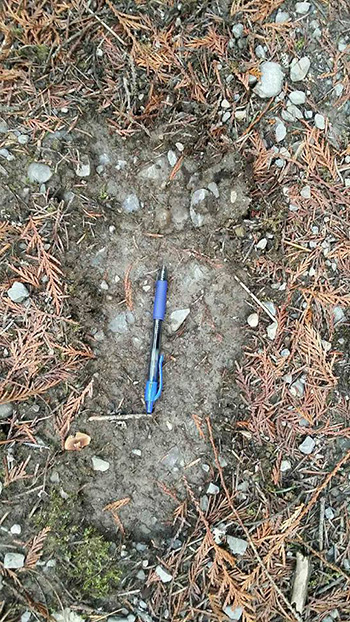
Bigfoot's FBI File Reveals Strange Story of a Monster Hunter and 15 Mysterious Hairs Live Science - June 6, 2019
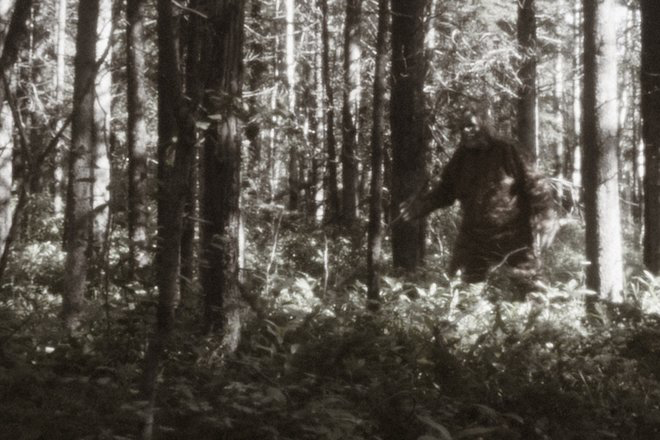
The U.S. government released Bigfoot's FBI file. It contains a few news clippings, and some formal letters to and from a monster hunter in the 1970s - leading to an examination of 15 hairs and some skin the hunter believed came from "a Bigfoot." It appears that Peter Byrne, that monster hunter, first wrote to the FBI on Aug. 26, 1976. His note, printed on fancy letterhead reading "The Bigfoot Information Center and Exhibition," suggested that the FBI was in possession of flesh and hair belonging to a mysterious creature, possibly belonging to a "Bigfoot." "Gentlemen," Byrne wrote, "Will you kindly, to set the record straight, once and for all, inform us if the FBI, has examined hair which might be that of a Bigfoot; when this took place, if it did take place; what the results of the analysis were."
Bigfoot Blamed for Strange Shrieks Live Science - January 29, 2013
Do new recordings from Oregon's Blue Mountains offer good evidence of the mysterious bipedal creature known as Bigfoot? That's what some are claiming after hearing a recording of strange roars and shrieks given to The Oregonian newspaper. When people think of Bigfoot evidence, casts of big footprints and blurry photos and films often come to mind. But some of the more interesting bits of evidence are sound recordings of alleged vocalizations. One company, Sierra Sounds, markets a CD called "The Bigfoot Recordings: The Edge of Discovery." Narrated by "Star Trek" actor Jonathan Frakes, the recording claims to have captured vocalizations among a Bigfoot family. The sounds include a series of guttural grunts, howls and growls.The liner notes offer testimonials from a "linguist" whose self-described credentials include playing the flute, speaking several languages, and having "a Russian friend who thinks I'm Russian." She confidently asserts that the tapes are not faked, and that the vocal range is too broad to be made by a human. She also suggests that Bigfoot individuals have a language, possibly including "Sasquatch swear words."

Bigfoot, also known as Sasquatch, is a figure in North American folklore alleged to inhabit remote forests, mainly in the Pacific northwest region of the United States and the Canadian province of British Columbia. In northern Wisconsin, Lakota Indians know the creature by the name Chiye-tanka, a Lakota name for "Big Elder Brother".
Bigfoot is sometimes described as a large, hairy bipedal hominoid, and many believe that this animal, or its close relatives, may be found around the world under different regional names, such as the Yeti of Tibet and Nepal and the Yowie of Australia.
Bigfoot is one of the more famous examples of cryptozoology, a subject that the scientific community tend to dismiss as pseudoscience because of unreliable eyewitness accounts, lack of scientific and physical evidence, and over-reliance on confirmation rather than refutation. Most experts on the matter consider the Bigfoot legend to be a combination of folklore and hoaxes.
Various descriptions have received, with little support from the scientific community, to date.
Bigfoot is generally described as a large hairy ape-like creature, ranging between 6-10 feet (2-3 m) tall, weighing in excess of 500 pounds (230 kg), and covered in dark brown or dark reddish hair. Alleged witnesses have described large eyes, a pronounced brow ridge, and a large, low-set forehead; the top of the head has been described as rounded and crested, similar to the sagittal crest of the male gorilla.
Bigfoot is commonly reported to have a strong, unpleasant smell by those who claim to have encountered it. The enormous footprints for which it is named have been as large as 24 inches (60 cm) long and 8 inches (20 cm) wide.
While most casts have five toes - like all known apes - some casts of alleged bigfoot tracks have had numbers ranging from two to six. Some have also contained claw marks, making it likely that a portion came from known animals such as bears, which have five toes and claws. Some proponents have also claimed that bigfoot is omnivorous and mainly nocturnal.
Scientists discount the existence of bigfoot and consider it to be a combination of folklore, misidentification, and hoax, rather than a living animal, in part because of the large numbers thought necessary to maintain a breeding population. A few scientists - such as Jane Goodall, and Jeffrey Meldrum - have expressed interest and belief in the creature, with Meldrum expressing that evidence collected of alleged Bigfoot encounters warrants further evaluation and testing.
Bigfoot remains one of the more famous examples of a cryptid within cryptozoology, and an enduring legend.
Wildmen stories are found among the indigenous population of the Pacific Northwest. The legends existed prior to a single name for the creature. They differed in their details both regionally and between families in the same community. Similar stories of wildmen are found on every continent except Antarctica. Ecologist Robert Michael Pyle argues that most cultures have human-like giants in their folk history: "We have this need for some larger-than-life creature."
Members of the Lummi tell tales about Ts'emekwes, the local version of bigfoot. The stories are similar to each other in terms of the general descriptions of Ts'emekwes, but details about the creature's diet and activities differed between the stories of different families.
Some regional versions contained more nefarious creatures. The stiyaha or kwi-kwiyai were a nocturnal race that children were told not to say the names of lest the monsters hear and come to carry off a person - sometimes to be killed.
In 1847, Paul Kane reported stories by the native people about skoocooms: a race of cannibalistic wild men living on the peak of Mount St. Helens. The skoocooms appear to have been regarded as supernatural, rather than natural.
Less menacing versions such as the one recorded by Reverend Elkanah Walker exist. In 1840, Walker, a Protestant missionary, recorded stories of giants among the Native Americans living in Spokane, Washington. The Indians claimed that these giants lived on and around the peaks of nearby mountains and stole salmon from the fishermen's nets.
The local legends were combined together by J. W. Burns in a series of Canadian newspaper articles in the 1920s. Each language had its own name for the local version. Many names meant something along the lines of "wild man" or "hairy man" although other names described common actions it was said to perform (e.g. eating clams).
Burns coined the term Sasquatch, which is used it in his articles to describe a hypothetical single type of creature reflected in these various stories. Burns's articles popularized both the legend and its new name, making it well known in western Canada before it gained popularity in the United States.
In 1951, Eric Shipton had photographed what he described as a Yeti footprint. This photograph (see below) generated considerable attention and the story of the Yeti entered into popular consciousness.
The notoriety of ape-men grew over the decade, culminating in 1958 when large footprints were found in Del Norte County, California, by bulldozer operator Gerald Crew. Sets of large tracks appeared multiple times around a road-construction site in Bluff Creek.
After not being taken seriously about what he was seeing, Crew brought in his friend, Bob Titmus, to cast the prints in plaster. The story was published in the Humboldt Times along with a photo of Crew holding one of the casts.
Locals had been calling the unseen track-maker "Big Foot" since the late summer, which Humboldt Times columnist Andrew Genzoli shortened to "Bigfoot" in his article.
Bigfoot gained international attention when the story was picked up by the Associated Press. Following the death of Ray Wallace - a local logger - his family attributed the creation of the footprints to him. The wife of Scoop Beal, the editor of the Humboldt Standard, which later combined with the Humboldt Times, in which Genzoli's story had appeared, has stated that her husband was in on the hoax with Wallace.
1958 was a watershed year for not just the bigfoot story itself but also the culture that surrounds it. The first bigfoot hunters began following the discovery of footprints at Bluff Creek, California. Within a year, Tom Slick, who had funded searches for Yeti in the Himalayas earlier in the decade, organized searches for bigfoot in the area around Bluff Creek.
As Bigfoot has become better known and a phenomenon in popular culture, sightings have spread throughout North America. In addition to the Pacific Northwest, the Great Lakes region and the Southeastern United States have had many reports of Bigfoot sightings.
About a third of all reports of Bigfoot sightings are concentrated in the Pacific Northwest, with most of the remaining reports spread throughout the rest of North America. Some Bigfoot advocates, such as cryptozoologist John Willison Green, have postulated that Bigfoot is a worldwide phenomenon. The most notable reports include:
Beck wrote a book about the alleged event in 1967, in which he argued that the creatures were mystical beings from another dimension, claiming that he had experienced psychic premonitions and visions his entire life of which the apemen were only one component. Speleologist William Halliday argued in 1983 that the story arose from an incident in which hikers from a nearby camp had thrown rocks into the canyon. There are also local rumors that pranksters harassed the men and planted faked footprints.
1941: Jeannie Chapman and her children said they had escaped their home when a 7.5 feet (2.3 m) tall Sasquatch approached their residence in Ruby Creek, British Columbia.
1958: Bulldozer operator Jerry Crew took to a newspaper office a cast of one of the enormous footprints he and other workers had seen at an isolated work site at Bluff Creek, California. The crew was overseen by Wilbur L. Wallace, brother of Raymond L. Wallace. After Ray Wallace's death, his children came forward with a pair of 16-inch (41 cm) wooden feet, which they said their father had used to fake the Bigfoot tracks in 1958.Wallace is poorly regarded by many Bigfoot proponents. John Napier wrote, "I do not feel impressed with Mr. Wallace's story" regarding having over 15,000 feet (4,600 m) of film showing Bigfoot.
1967: Roger Patterson and Robert Gimlin reported that on October 20 they had captured a purported Sasquatch on film at Bluff Creek, California. This came to be known as the Patterson-Gimlin film. Many years later, Bob Heironimus, an acquaintance of Patterson's, said that he had worn an ape costume for the making of the film.
2007: On September 16, 2007, hunter Rick Jacobs captured an image of a supposed Sasquatch by using an automatically triggered camera attached to a tree, prompting a spokesperson for the Pennsylvania Game Commission to say that it was likely an image of "a bear with a severe case of mange." The photo was taken near the town of Ridgway, Pennsylvania, in the Allegheny National Forest.
Various types of creatures have been suggested to explain both the sightings and what type of creature Bigfoot would be if it existed. The scientific community typically attributes sightings to either hoaxes or misidentification of known animals and their tracks. While cryptozoologists generally explain Bigfoot as an unknown ape, some believers in Bigfoot attribute the phenomenon to UFOs or other paranormal causes. A minority of proponents of a natural explanation have attributed Bigfoot to animals that are not apes such as the giant ground sloth.
In 2007, the Pennsylvania Game Commission said that photos the Bigfoot Field Researchers Organization claimed showed a juvenile Bigfoot were most likely of a bear with mange. Jeffrey Meldrum, on the other hand, said the limb proportions of the suspected juvenile in question were not bear-like, and stated that he felt they were "more like a human."
A tale presented in Theodore Roosevelt's 1892 book The Wilderness Hunter (reprinted in his 1900 book Hunting the Grisly and Other Sketches) describing an encounter between two hunters and a violent bear is sometimes presented by Bigfoot proponents as historical evidence of the creature's existence.
In 2007, the Pennsylvania Game Commission said that photos the Bigfoot Field Researchers Organization claimed showed a juvenile Bigfoot were most likely of a bear with mange.[41][46] Jeffrey Meldrum, on the other hand, said the limb proportions of the suspected juvenile in question were not bear-like, and stated that he felt they were "more like a human."
A tale presented in Theodore Roosevelt's 1892 book The Wilderness Hunter (reprinted in his 1900 book Hunting the Grisly and Other Sketches) describing an encounter between two hunters and a violent bear is sometimes presented by Bigfoot proponents as historical evidence of the creature's existence.
Both scientists and Bigfoot believers agree that many of the sightings are hoaxes or misidentified animals. Cryptozoologists Loren Coleman and Diane Stocking have estimated that as many as 70 to 80 percent of sightings are not real.
Bigfoot sightings or footprints are often demonstrably hoaxes. Author Jerome Clark argues that the "Jacko affair", involving an 1884 newspaper report of an apelike creature captured in British Columbia, was a hoax. Citing research by John Green, who found that several contemporary British Columbia newspapers regarded the alleged capture as very dubious, Clark notes that the Mainland Guardian of New Westminster, British Columbia, wrote, "Absurdity is written on the face of it."
On July 14, 2005, Tom Biscardi, a long-time Bigfoot enthusiast and CEO of Searching for Bigfoot Inc., appeared on the Coast to Coast AM paranormal radio show and announced that he was "98% sure that his group will be able to capture a Bigfoot which they have been tracking in the Happy Camp, California area." A month later, Biscardi announced on the same radio show that he had access to a captured Bigfoot and was arranging a pay-per-view event for people to see it. Biscardi appeared on Coast to Coast AM again a few days later to announce that there was no captive Bigfoot. Biscardi blamed an unnamed woman for misleading him, and the show's audience for being gullible.
On July 9, 2008, Rick Dyer and Matthew Whitton posted a video to YouTube claiming that they had discovered the body of a dead Sasquatch in a forest in northern Georgia. Tom Biscardi was contacted to investigate. Dyer and Whitton received $50,000 from Searching for Bigfoot, Inc., as a good faith gesture. The story of the men's claims was covered by many major news networks, including BBC, CNN, ABC News, and Fox News. Soon after a press conference, the alleged Bigfoot body arrived in a block of ice in a freezer with the Searching for Bigfoot team. When the contents were thawed, it was discovered that the hair was not real, the head was hollow, and the feet were rubber. Dyer and Whitton subsequently admitted it was a hoax after being confronted by Steve Kulls, executive director of Squatchdetective.com.
The scientific community discounts the existence of Bigfoot, as there is no evidence supporting the survival of such a large, prehistoric ape-like creature. The evidence that does exist points more towards a hoax or delusion than to sightings of a genuine creature.
In a 1996 USA Today article titled "Bigfoot Merely Amuses Most Scientists", Washington State zoologist John Crane says, "There is no such thing as Bigfoot. No data other than material that's clearly been fabricated has ever been presented." In addition to the lack of evidence, scientists cite the fact that Bigfoot is alleged to live in regions unusual for a large, nonhuman primate, i.e., temperate latitudes in the northern hemisphere; all recognized nonhuman apes are found in the tropics of Africa and Asia. Thus, as with other proposed megafauna cryptids, climate and food supply issues would make such a creature's survival in reported habitats unlikely.
Furthermore, great apes are not found in the fossil record in the Americas, and no Bigfoot remains have ever been found. Indeed, scientific consensus is that the breeding population of such an animal would be so large that it would account for many more purported sightings than currently occur, making the existence of such an animal an almost certain impossibility.
A few scientists have been less skeptical about the claims of the existence of sasquatch. Jeffrey Meldrum characterizes the search for Sasquatch as a valid scientific endeavor and says that the fossil remains of an ancient giant ape called Gigantopithecus could turn out to be ancestors of today's commonly known Bigfoot.
John Napier asserts that the scientific community's attitude towards Bigfoot stems primarily from insufficient evidence.
Other scientists who have shown varying degrees of interest in the legend are anthropologist David Daegling, field biologist George Shaller, Russell Mittermeier, Daris Swindler, Esteban Sarmiento, and discredited racial anthropologist Carleton S. Coon.
Jane Goodall, in a September 27, 2002 interview on National Public Radio's "Science Friday", expressed her ideas about the existence of Bigfoot. First stating "I'm sure they exist", she later went on to say, chuckling, "Well, I'm a romantic, so I always wanted them to exist", and finally: "You know, why isn't there a body? I can't answer that, and maybe they don't exist, but I want them to.
However, the vast majority of evolutionary biologists, anthropologists and paleontologists completely dismiss the possibility of the existence of sasquatch.

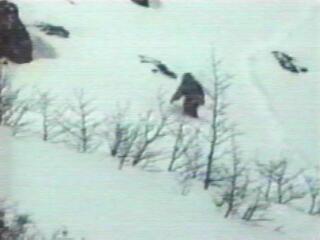
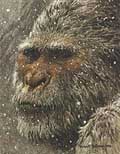
The Tibetan name for the Abominable Snowman, a humanlike monster whose tracks have been discovered in the frigid lands of perpetual snow in the Himalayan regions of India, Nepal, and Tibet. According to locals, the Yeti is but one of several unidentified creatures that inhabit the highlands of southern Asia. Several sightings, mainly of footprints, have been reported by westerner explorers throughout the years.
Why don't people see the Yeti any more? BBC - November 2, 2015
Until recently it was common for people in Bhutan to share stories of their encounters with the Himalayan yeti. But with the arrival of modernity, villagers no longer need to climb high into the mountains, where they once saw traces of the yeti - or thought they did. So a legend is slowly fading away.
1832 - B.H. Hodson,the U.K. representative in Nepal, described a hirsute creature who reportedly had attacked his servants. The natives called the beast "rakshas," which means "demon." This was the first report of the Yeti made by a Westerner.
1889 - British army major L. A. Waddell found what he took to be large footprints in the snow on a high peak northeast of Sikkin. His bearers told him that these were the tracks of a man-like creature called Yeti, and that it was quite likely to attack humans and carry then away as food.
1913 - A group of Chinese hunters reportedly wounded and captured a hairy man-like creature, that the locals soon named the "snowman". This creature was supposedly kept captive in Patang at Sinkiang province for a period of five months until it died. It was described as having a black monkey-like face and large body covered with silvery yellow hair several inches long; it's hands and feet were man-like and the creature was incredibly strong.
1914 - J. R. P. Gent, a British forestry officer stationed in Sikkim, wrote of discovering footprints of what must have been a huge and amazing creature.
1921 - Members of a British expedition (led by Col. Howard-Bury) climbing the north face of Mount Everest sighted some dark figures moving around on a snowfield above them. When the explorers reached the spot, at some 17,500 feet, the creatures were not there but had left behind some huge, humanlike footprints in the snow.
1923 - Major Alan Cameron, with the Everest Expedition of that year, observed a line of huge and dark creatures moving along a cliff face high above the snowline. Pictures of the creatures' tracks were taken two days later, when the expedition reached the area where they were seen.
1925 - A Greek photographer and member of the Royal Geographical Society named N. A. Tombazi glimpsed a creature he later described as "exactly like a human being, walking upright and stopping occasionally to uproot or pull some dwarf rhododendron bushes." Tombazi, who was at about 15,000 feet up in the mountains, later reached the spot where he sighted the creature, only to also find some intriguing tracks in the snow.
1936 - An expedition led by H. W. Tilman found strange footprints in the snow by the outer reaches of the snowline on the slopes approaching Mount Everest.
1937 - Returning from a campaign in Tibet, British explorer Frank Smythe relayed several reports of strange hairy wildmen made by the native Sherpas and Tibetans. He also claimed to have personally seen tracks of the creature at the 14,000-foot level.
1938 - The Yeti emerges as creatures of kindness and sympathy according to the story of Captain d'Auvergne, the curator of the Victoria Memorial near Chowringhee in Calcuta. The Captain claims that, injured while traveling on his own in the Himalayas and threatened with snow-blindness and exposure, he was saved from death by a 9 foot tall creature resembling a pre-historic human which, after carrying him several miles to a cave, fed and nursed him until he was able to make his way back home.
1942 - Slavomir Rawicz best selling book, The Long Walk published in 1952, telling how he and six friends escaped from a Siberian war camp and made their way to freedom in India by crossing the Himalayas describes an encounter with two 8 foot tall creatures somewhere between Bhutan and Sikkim. According to Slavomir, he and his companions watched the outsized beasts for over 2 hours, from a distance of 100 yards.
1948 - Norwegian uranium prospector Jan Frostis claimed he was attacked by one of two Yetis he stumble upon near Zemu Gap, in Sikkim. His shoulder was badly mangled and he required extensive medical treatment to recover from his lesions.
1949 - A Sherpa named Tenzing claimed to have seen playing in the snow near a monastery. This was the same Sherpa that shared the fame of Sir Edmund Hillary in the first successful ascent of Mount Everest.
1950 - A patch of skin and a mummified finger and thumb were found in the Himalayan mountains. Zoologists and anthropologists considered the fragments to be "almost human" and "similar in some respects to that of Neanderthal man" even though they could not be associated to any known living species.
1951 - The Everest Reconnaissance Expedition (organized to evaluate routes for an attempt to ascend Everest) encountered fresh tracks at 18,000 feet. During the following months, several additional sightings of Yeti tracks were reported.
1953 - New Zealander Edmund Hillary and Sherpa Tenzing Norgay spot giant footprints during their conquest of Mount Everest.
1954 - The London Daily Mail's financed expedition (originally to hunt and catch a live Yeti) examined some supposedly 'authentic' Yeti scalps, but determined that these were mostly fakes made out of from animal skin; a small handful of them proved to be intriguing though, and zoologists were unable to link them to any known animals. The expedition also found footprints and droppings that, when analyzed, proved to contain both animal and vegetable matter.
1955 - Frenchman Abb¸ Bordet followed three separate trails of footprints that belonged to an unknown creature.
1957 - Texas oilman Thomas Slick sponsors a Yeti hunt. His expedition came back solely with reports made by Nepalese villagers that five people had been killed by severe battering from Yeti over the preceding four years.
1958 - An American scientist working in Katmandu (Nepal), Dr. Norman Dyrenfurth, reports to have explored caves that were at some time inhabited by a type of "very low grade of human or near human creatures", presenting documentation and physical evidence in the form of hair samples, plaster casts of footprints, and discarded food scraps. Also in 1958 a Dr. Alexander Pronin reports seeing the creature while he was in the Pamirs (a unique high mountain complex located primarily in Tajikistan).
1960-61 - The Himalayan Scientific and Mountaineering Expedition also found some unusual tracks in the snow.
1970 - After hearing a strange noise near Mount Annapurna in Nepal, mountaineer Don Whillans tracks and watches a strange humanoid creature for about twenty minutes through his binoculars before it lumbers away.
1978 - Lord Hunt photographed Yeti tracks.
1986 - Climber Reinhold Messner reported a close-up sighting of an Yeti as it came into sight from behind a tree.
1992 - Julian Freeman-Attwood and two other men camping at a secluded spot on a remote glacier in Mongolia reported finding an unusual trail of heavy footprints one morning on the snow outside their tent, definitely made by a creature larger and heavier than a human.
1998 - American climber Craig Calonica, on Mount Everest, reported seeing a pair of yetis while coming down the mountain on its Chinese side. Both had thick, shiny black fur, he said, and walked upright.
Video: British scientist 'solves' mystery of Himalayan yetis BBC - October 17, 2013
Research by a British scientist has concluded that the legendary Himalayan yeti may in fact be a sub-species of brown bear. DNA tests on hair samples carried out by Oxford University genetics professor Bryan Sykes found that they matched those from an ancient polar bear. He subjected the hairs to the most advanced tests available. He says the most likely explanation for the myth is that the animal is a hybrid of polar bears and brown bears. Prof Sykes told the BBC that there may be a real biological animal behind the yeti myth.
Video: On the trail of the 'Indian Yeti' BBC - June 19, 2008
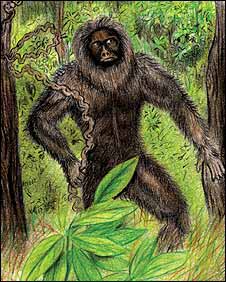
In the US it's known as bigfoot, in Canada as sasquatch, in Brazil as mapinguary, in Australia as a yowie, in Indonesia as sajarang gigi and, most famously of all, in Nepal as a yeti. The little known Indian version of this legendary ape-like creature is called mande barung - or forest man - and is reputed to live in the remote West Garo hills of the north-eastern state of Meghalaya.
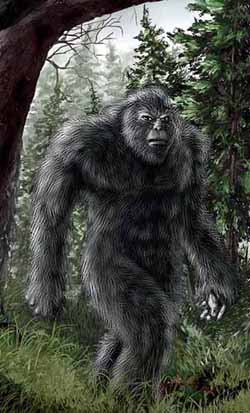
Bigfoot's Canadian counterpart, known by its Salish Indian name meaning "hairy man."
Allegedly sighted for centuries, descriptions vary from being a creature at least eight feet tall, long powerful arms, thick hair and a foul smell, to being a semi-clothed, tool carrying hominid supposedly of "man" height.
Another names by which is known, depending on the North American region, are Arulataq (Alaska), Grassman (Ohio), Momo (Missouri), Oh-mah (California), Old Yellow Top (Ontario), Skunk Ape (Florida), Windigo (Quebec), Woods Devil (New Hampshire), Wookie (Louisiana), Nuk-luk, Nakani (North West Territories) or simply Bushman.
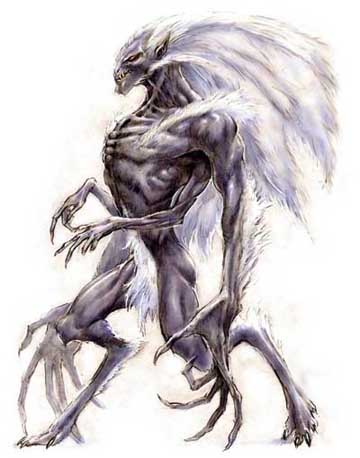
Huge mysterious human-like creature, allegedly living in the forests of Quebec. According to Indian legends, the creature "goes naked in the bush and eats Indians, and makes a sinister hissing noise, often accompanied by fearful howls, to strike terror into the hearts of everyone who hears it."
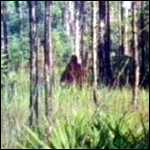
The Florida Skunk Ape is supposedly a seven-foot-tall gorilla-like creature said to resemble the legendary Abominable Snowman. Witnesses in the Florida Everglades have claimed to have spotted the red-haired Bigfoot, known locally as a Skunk Ape because of its appalling smell. The National Parks Service dismisses the stories as a hoax, but American tribes that live in the swamps insist it is real.

Also known as Yoser, Tjangara, Yay-ho, Koyoreowen (southern Australia), Jimbra, Jingera, Turramulli, and Lo-an (western Australia). Yet another cousin of the Bigfoot, this time from down under. Reports of a Sasquatch like creature are also numerous throughout Australia, ever since European settlers first entered the continent. Before the coming of the settlers, Yowie sightings were made by the Aborigines and remembered in their folklore.
An earlier name for the creature was 'Yahoo', which according to some accounts was an aborigine term meaning "devil", "devil-devil" or "evil spirit." More likely, the indirect basis for the name was Jonathan Swift, whose Gulliver's Travels book (1726) includes a subhuman race named the Yahoos. Learning of the aborigines' fearful accounts of this malevolent beast, nineteenth-century European settlers in all probability applied the name Yahoo to the Australian creature themselves. The term "Yowie" stared to be used in the 1970's, apparently because of the aborigine word 'Youree', or 'Yowrie', apparently the legitimate native term for the hairy man-monster. One can easily assume the Australian accent could distort "Youree" into "Yowie."
Sightings of the Yowie take place mostly in the south and central Coastal regions of New South Wales and Queensland's Gold Coast. In fact, according to local naturalist Rex Gilroy, the Blue Mountain area west of Sydney is home to more than 3,200 historical sightings of such creatures. In December 1979, a local couple (Leo and Patricia George) ventured into the region for a quiet picnic. Suddenly, they came across the carcass of a mutilated kangaroo; moreover, said the couple, the apparent perpetrator was only forty feet away. They described a creature at least ten feet tall, and covered with hair, that stopped to stare back at them before finally disappearing into the brush.
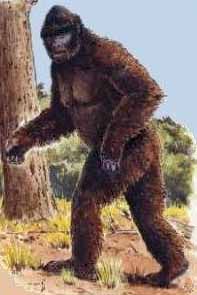
Or Mapinguari. Also known as Isnashi. Brazil's Bigfoot, described as a tall black-furred hominid usually seen in the jungles along the 'Rio Araguaia', a large river in Brazil's state of Mato Grosso do Sul.
Ape-like creatures have been reported in many areas of Brazil for over two hundred years, but it seems that this central area of this immense and diversified country is the 'hotspot' for them.
In March and April of 1937 one of these creatures supposedly went on a three week rampage at Barra das Gar¨as, a small farming town 300 miles southeast of the city of Cuiab‡, capital of the central state of Mato Grosso do Sul. A large number of heads of cattle were slaughtered by somebody or something with super-human strength, enough to torn out their huge tongues. Reports included unconfirmed sightings, humanoid-like tracks as long as 18 inches, and horrible roaring from the woods. All together, over one hundred heads of yellow cattle of old Spanish origin were killed, all the way to Ponta Branca, located 150 miles south of Barra das Gar¨as. This Mapinguary rampage made the major newspapers in Rio de Janeiro and S‹o Paulo.
Other reports from South America describe the Mapinguari as a large foul smelling nocturnal animal, covered in red hair and with a frightful screaming cry. This other version of the legendary creature is supposedly a strict vegetarian, with feet that are turned backwards and claws capable of ripping apart the palm trees it feeds on. Other local names for this type include 'capˇ-lobo' (wolf's cape), 'm‹o de pil‹o' (pestle hand), and 'pˇ de garrafa' (bottle foot).
According to old Indian, 'seringueiro' (rubber tree worker) and 'caboclo' (local mixed race people) legends, the Mapinguary was a man whose hubris led him to seek immortality and who is now relegated to wandering the forest forever as a stinking, shaggy, one-eyed beast. Fifteen feet tall and with hair so thick it makes it invulnerable to bullets, swords, knifes, arrows and spears, the creature loves tobacco and twists off the upper skulls of its human victims so as to suck up their gray matter. But its most freaky feature is its 'extra mouth' in the middle of its belly! When it feels threatened, it lets out a truly vile stench -something like commingled garlic, excrement, and rotting meat -from this second mouth, which, the Indians say, is strong enough to suffocate any attacker. Because of this despicable odor, the creatures are often followed by clouds of flies, and the strongest warriors are forced to flee from the smell of the monster alone; others find themselves dazed and sick for days after an encounter.
Because of such reports, legends and descriptions, a small number of naturalists believe that these are surviving specimens of the giant ground sloth, Mylodons, generally assumed to have died out around ten thousand years ago. They were red-haired vegetarians that emerged about 30 million years ago and roamed the Americas, the Caribbean, and Antarctica. With large claws that curled under and faced backward when they walked on all fours, these giant marsupials could also stand on their hind feet like people. Some species had dermal ossicles, bony plates that made their skin very tough.
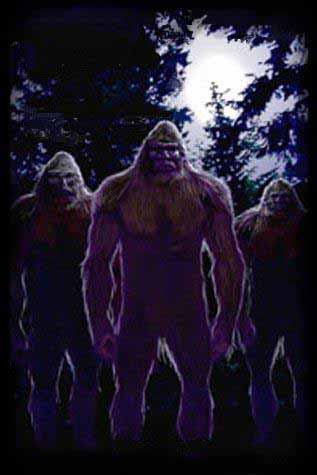
South America's Bigfoot -- Ape-like creatures have been reported in many areas of South America, and they go by many different names, depending on the region. Some of these names are:
Aluxes, Goazis and Guayazis (dwarf-like man-faced animals).
Aigypans and Vasitris (evil man-like beasts).
Matuyus and Curupiras (wild men with their feet pointing backwards, which supposedly help the wild animals and are defenders of nature and ecology).
Curinqueans (giants measuring twelve feet tall).
Di-di or Didi, Mono Grande and the Mapinguary (Sasquatch-like creatures).
Since the arrival of the Portuguese and Spanish in South America, a steady stream of reports about bestial and dangerous sub-humans have filtered out of the hinterland. None is more compelling than the one made by Colonel P. H. Fawcett, made world famous by his dramatic and still unexplained disappearance with his eldest son in this area. The Colonel's diaries were preserved up to his last fatal expedition, and published by his son, Brian Fawcett, under the title 'Lost Trails, Lost Cities'. In it, the Colonel describes an encounter in 1914 with a group of enormous hairy savages that, although looked very primitive, were carrying bows and arrows. Apparently these wild men could not speak, but just grunt, and upon arriving their village, the Colonel and his group were on the verge of being attacked, barely avoiding capture or death by firing their guns into the ground at the ape-men's feet, who then fled in terror.
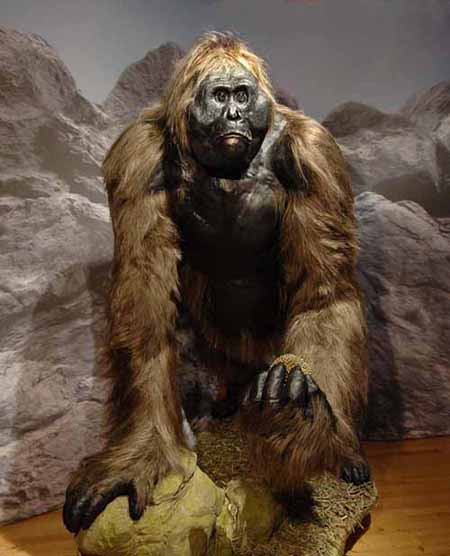
An alleged mysterious creature, half-human, half-ape, allegedly living in the remote forests of central and southern China. It is also known as Yeren and Xueren (also the name of like creatures in the Philippines)
The creature is said to stand an average of six and a half feet tall and to be covered in thick brown or red hair. It is bi-pedal and has a hefty abdominal region as well as an ape-like muzzle, large ears and eyes like that of a human, leaving behind large footprints, up to sixteen inches long, with five toes, four small toes held close together and a larger toe that points outward slightly.
According to Chinese folklore, the creature eats people. Coming across a human, it grips his or her arms tightly, making escape impossible. It is apparently so overjoyed by trapping its prey that it faints with mirth - but without losing its hold. When it returns to its senses, it kills and eats its victim. Thus travelers in the mountains were advised to wear a pair of hollow bamboo cylinders on their arms. If a Wildman caught them, they could then, while the creature was in swoon, slip their arms out of the cylinders and escape. Reports of the creature go back to as far as 2000 years.
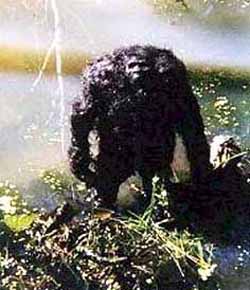
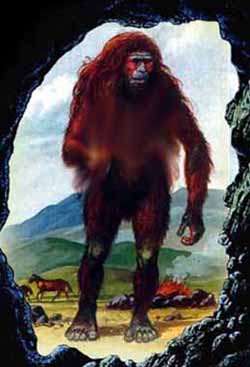
Also Almasty and Albasty. Strange apelike creatures allegedly resembling Neanderthal man that reportedly live in the Caucasus Mountains, in the republic of Kazakhstan, central Asia.
In the Caucasus, Almas (which in the Mongolian language means 'wildman') are well known by the local people, who tell numerous stories of an apparent familiarity between humans and these creatures. Eyewitness accounts dating back hundreds of years describe Almas communicating with humans by means of gestures. There were even stories of Almas bartering food for trinkets.
Adult Almases have been described as being at least 5 ft tall, shy, hairy, with prominent eyebrow ridges, a receding chin and a jaw that protrudes out.
Other names by which these creatures are known, depending on the particular region, are 'Wind-Man', Abnuaaya, Bekk-Bok, Biabin-Guli, Gul-Biavan, Guli-Avan, Golub-Yavan, Kaptar, Kra-Dhan, Ksy-Giik or Ksy Gyik, Mirygdy, Mulen and Voita.
1420 - The first known printed reference on the Almas was made by a Bavarian named Hans Schiltberger. He traveled through the Tien Shan mountains as a captive to the Mongols. During his imprisonment he kept a journal in which he wrote:
"In the mountains themselves live a wild people, who have nothing in common with other human beings, a pelt covers the entire body of these creatures. Only the hands and face are free of hair. They run around in the hills like animals and eat foliage and grass and whatever else they can find. The Lord of the Territory made Egidi a present of a couple of forest people, a man and a woman, together with three untamed horses the sizes of asses and all sorts of other animals which are not found in German lands and which I cannot therefore put a name to."
1807-1867 - Sightings reported at Khalkha, the Galbin Gobi and Dzakh Soudjin Gobi as well as in Inner Mongolia; also at the Gourban Bogdin Gobi, Chardzyn Gobi and the Alachan desert.
Mid 1800s - A wild reddish-black hair covered woman with both mongoloid and negroid features, dark skin, broad body, large hands and feet and a sloped forehead, was allegedly captured in the western Caucausus region of Abkhazia, and given the name Zana or Zanya. According to accounts, she was very physically powerful, able to perform feats of exceptional strength. While in captivity, Zana was passed on through a succession of owners, including noblemen, and mothered several children (she was reputed to have a fondness for wine, which supposedly played a role in her pregnancies). According to the story, she had as many as 6 offspring, by different men. Of these, the first 2 perished, due to Zana washing them in cold water after birth. The other 4 survived with the help of the local village women, who took care of the children. They were fairly normal, except for being dark and physically powerful, and grew up accepted among the villagers. Each of these children reproduced and allegedly had descendants throughout the region, up to nowadays. Zana died sometime in the 1880s.
1881 - As almost to confirm Hans Schiltberger's journal, a Russian named Nicholai Przewalski rediscovered the horses the sizes of asses and called them, of course, the "Przewalski horses"; he also reported seeing 'wildmen' in Mongolia in 1871.
1906 - Badzare Baradyine, while on a caravan at the desert of Alachan, reports seeing an "hairy man standing on the top of a sand dune, outlined against the sunset." After being approached by the Imperial Russian Geographical Society's president and asked not to publish the incident, Badzare complies, but relays the information about his sighting to a personal friend, Mongolian professor Tsyben Zhamtsarano, who in turn begins a lengthy and determined investigation of the Almas.
1907-1940 - Professor Tsyben Zhamtsarano compiles eyewitness' acounts and recruits an artist to draw the likeness of the Almas based on the gathered descriptions. He also plots sightings locations and dates on a map of the region. After being imprisoned in Russia for a number of years, the professor dies in 1940. His files vanish, and are rumored confiscated by the authorities.
1937 - Dordji Meiren, an associate of Professor Zhamtsarano, reports seeing a carpet made out of a hide of an Almas, being used by lamas at their monastery in ritual ceremonies.
1941 - A Russian unit fighting the Germans in the Caucasus near Buinakst is asked by some partisans to look at an unusual prisoner. According to the unit's commander, Lt. Col. Vargen Karapetyan, the captive 'man' was naked, hairy, and covered with lice; he obviously didn't understand speech and appeared to be dim-witted, blinking often; he was evidently afraid, but made no attempt to defend himself when Karapetyan pulled hairs from his body. He was kept in a barn, because, as the partisans explained, in a heated room he stank and dripped sweat. Not wanting to get involved, Karapetyan told the partisans to do what they wanted with the prisoner. A few days later he heard that the prisoner had escaped, but according to a later report made by the Ministry of the Interior in Daghestan, the 'wild man' had been executed as a deserter after being court-martialed.
1963 - Ivan Ivlov, a Russian pediatrician, sees a family of manlike creatures consisting of a male, female and a small child, standing on a mountain slope. Ivlov observed the creatures through field glasses for some time before they vanished behind a jutting rock. Ivlov's Mongol driver also sees the creatures and assures him they are common in the area.
1964 - Russian historian Boris Porshnev visits the place where Zana had reportedly lived. Several centenarians (Caucasus people are noted for their longevity) claimed to have known her and to have attended her funeral. Dr Porshnev also meets a couple of the alleged descendants (her grandchildren) of the wild woman, and wrote of the episode:
"From the moment I saw Zana's grandchildren, I was impressed by their dark skin and negroid looks. Shalikula, the grandson, has unusually powerful jaw muscles, and he can pick up a chair, with a man sitting on it, with his teeth."
During the next few years, Porshnev and a colleague tried to find Zana's remains in the Genaba (the family name of her descendants) graveyard, and although they found the vaguely Neanderthaloid bones of what they speculated was one of her children, they never discovered the remnants of the Almas herself.
1972 - An unnamed Russian doctor met a family of Almas, according to British anthropologist Myra Shackley, who adds that their "very simple lifestyle and the nature of their appearance suggests strongly that Almases might represent the survival of a prehistoric way of life, and perhaps even of an earlier form of man. The best candidate is undoubtedly Neanderthal man."
1985 - Maya Bykova, an assistant to Dr Boris Porshnev (yes, the same one from 1964) at Moscow's Darwin Museum, is reported to have actually observed a hominoid of unknown identity, a creature nicknamed by the ethnic Mnasi people as Mecheny, or "marked," because of the the whitish skin patch seen on its left forearm, the only part of its body not covered by red-brown hair.
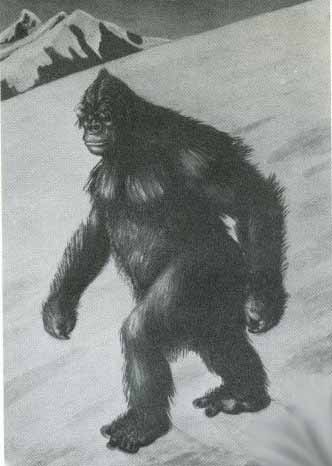
Another Hymalayan name for Yeti. The Meh-Teh ("man-beast") is a type of Yeti supposedly proportioned more like a hairy heavy set man (but it leaves a most unhuman type of footprint), and the Dzu-Teh like a gigantic ape-man. Another type of Yeti (pygmy size) is called Teh-lma.
The Meh-Teh is allegedly a very bestial and shy type of hairy hominid, with a animal-like behavior and thick reddish-brown to black fur, a conical head, stout neck, wide mouth with no lips, and long arms which reach almost to its knees, supposedly inhabiting the Tibetan upper plateau forests. Its five-toed feet are short and very broad, with a second toe longer than the big toe.
lso known as Chimiset, Chimisit (these, like Chemosit, mean 'devil' in the region's folklore) and Nandi Bear (after a Kenyan tribe), it is considered by some to be Africa's Bigfoot, although its description varies from those of sasquatch-like creatures.
Reports of the creature are numerous in the dark continent, specially in east-central Kenya. It is described as being as large as a man, long reddish to yellow hair, short broad tail, sometimes going on four legs, sometimes on two, and a general appearance of a huge, very fierce baboon. It is said to be as comfortable on the tree tops as it is on the ground, and to attack humans on sight, allegedly being responsible for several killings of men and live stock. According to some tales, it is specially fond of brains.
Other names by which the creature is known, depending on the part of Africa, are Duba (the Swahili and villages along the Tana river), Kerit, Shivuverre (Kakumega country, Kenya), Kikomba (West Africa), Koddoelo (Ngao state, Kenya), Sabrookoo (Kenya/Uganda frontier), Engargiya (Uganda), Gadett (Lumbwa district, Kenya), Ngoloko (Tanzania), Kikambangwe and Ikimizi (Ruanda).
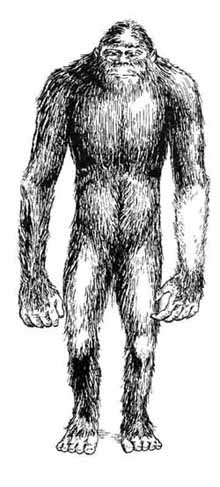
Chuchunaa is Siberia's Bigfoot. The Chuchunaa (outcasts or fugitives) were reported by a branch of the Soviet Academy of Science as recently as the 1950s in the bitterly cold and forbidding region of northeast Siberia, who speculated that they might represented the last surviving remnants of paleo-asiatic aborigines that retreated to the upper reaches of the Yana and Indigirka rivers.
These people are said to have an extremely limited range of oral sound. This may have been a genetic mutation - or is it an indication of these people's Neanderthal origin?
The Chuchunaa are described as being very tall with a protruding brow and long matted hair, usually sporting some type of animal skin covering. Locals swear he is a man-eater. Recent reports suggest that they have withdrawn to even more remote areas away from encroaching civilization.
Japan's Sasquatch. Sightings of a Bigfoot like creature are also reported in the Japanese islands, specially in the Hibayama mountains in Hiroshima. Another local names for the Higabon are Kappa and Mu-Jimi
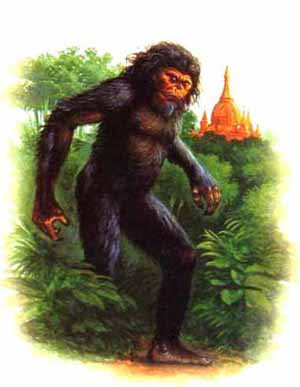
The Nguoirung is also known as the Vietnamese Wildman, or "Forest People". Appearance and legends are similar as for the Wildman of China; it is described as being approximately six feet tall and completely covered with hair except for the knees, the soles of the feet, the hands and the face. The hair ranges in color from gray to brown to black. The creature walks on two legs and has been reported seen both solitary and moving in small clans.
Along the Laotian border the beast is called Khi-Trau, meaning "buffalo monkey" or "big monkey".
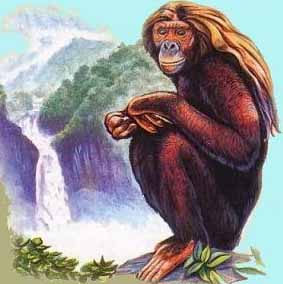
Also Orang-Pendek (Little Man) and Orang Letjo (Gibbering Man).
Sumatra's Sasquatch. Other local names include Gugu, Sedapa, Sedabo and Atu. They are said to stand between three and five feet tall (a few reports describe slightly taller specimens), to be covered with short dark hair, with a thick, bushy mane going halfway or farther down the back, and to have a smooth, hairless brown face.
Witnesses frequently mention the Orang-Pendek's startlingly humanlike appearance, thus its name. Sightings have been reported for centuries on Sumatra, but what is considered to be the first modern sighting happened in 1916, described in an article by Dr. Edward Jacobson. He stated that, while camped near the base of Boekit Kaba mountain, some of his scouts sighted the creature. He also claimed to have found some footprints at Mount Kerintji.
Local folklore tells that these creatures walk with backward-pointing feet, to confuse anyone daring enough to track them. The local Kubu tribespeople also claim that unless tobacco was left for them at night, the Sedapas would go on the rampage, screaming and yelling as they destroyed the natives' camp.

PALEONTOLOGY - APE FOSSILS